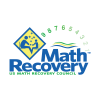Math Recovery
Impact
Math Recovery® teaching is having the right task, for the right student, at the right time. This is done through three core elements of our professional development courses. 1) Educator Development: We increase knowledge relating to the teaching and learning of mathematics, which facilitates improvements in instructional practices. 2) Student Assessment: We use dynamic diagnostic assessments to understand a student’s current thinking. Then, building upon students’ current knowledge, learning progressions provide a framework to guide instructional decisions. 3) Instructional Strategies: We promote student inquiry and purposeful selection of teaching topics, instructional settings and tasks within your current math curriculum. Combined, these lead to proven and long-term improvement in student mathematics performance. Math Recovery professional development is built on the foundation of strong ongoing research. (see www.mathrecovery.org/research) As a registered 501(c)(3) nonprofit organization our mission is to transform numeracy education, connect research with practice and empower educators to advance student mathematical thinking and success through Math Recovery principles.
Accomplished
- Need Accomplished
- Evaluation Accomplished
- Sustainability Accomplished
- Replication & Scalability Accomplished
- Partnerships Accomplished
- Capacity Accomplished
- Challenging & Relevant Content Accomplished
- STEM Practices Developing
- Inspiration Developing
- Under-Represented Groups Accomplished

Hands down, this is the most applicable and exciting teacher training I have ever had! I feel empowered to be able to really effect student’s understanding of not just how to do math, but how numbers and math work!
Ludington, MI
Design Principles
The programs in this database clear a high bar. STEMworks reviewed each program against the Design Principles for Effective STEM Philanthropy. Programs must be Accomplished () across all Design Principles, or be Developing (
) in a maximum of three areas.
Overarching Principles
-
Need Accomplished
Identify and target a compelling and well-defined need.
-
Evaluation Accomplished
Use rigorous evaluation to continuously measure and inform progress towards the compelling need identified.
-
Sustainability Accomplished
Ensure work is sustainable.
-
Replication & Scalability Accomplished
Demonstrate replicability and scalability.
-
Partnerships Accomplished
Create high impact partnerships.
-
Capacity Accomplished
Ensure organizational capacity to achieve goals.
STEM Principles
-
Challenging & Relevant Content Accomplished
Offer challenging and relevant STEM content for the target audience.
-
STEM Practices Developing
Incorporate and encourage STEM practices.
-
Inspiration Developing
Inspire interest and engagement in STEM.
-
Under-Represented Groups Accomplished
Identify and address the needs of under-represented groups.
Program Overview
US Math Recovery Council® professional development courses increase teachers’ knowledge and understanding of how children think about and learn mathematics. The Math Recovery® professional development opportunities are aimed at a variety of mathematics educator roles and grade levels. Classroom teacher/Special Education/Title I teachers: Add+VantageMR® Course 1 –Grades K-4 * Add+VantageMR® Course 2 –Grades 1-5 * Add+VantageMR® Fractions –Grades 3-8 Our Add+VantageMR® courses empower teachers to use dynamic diagnostic assessments to make data-driven instructional decisions. Mathematics Specialists/Leaders/Coaches: Math Recovery® Specialist Part 1 * Math Recovery® Specialist Part 2 Our Math Recovery Specialist courses provide a complete intervention curriculum to participants preparing them to provide targeted intervention and support mathematics initiatives. Courses for those who want to teach Math Recovery® to others in their district: Add+VantageMR® Champion * Add+VantageMR® Fractions Champion * Math Recovery® Specialist Leader. Participants who have taken our leadership courses are able to scale delivery of Math Recovery® professional development to enact cost-effective systemic change. All Math Recovery® courses have the opportunity to earn college credit.
Funders and Partners
Massachusetts Department of Education, Michigan Department of Education, Albuquerque Public Schools, Fairfax County Public Schools, Spokane Public School, Green Bay Area Public Schools, SAGE publishing
